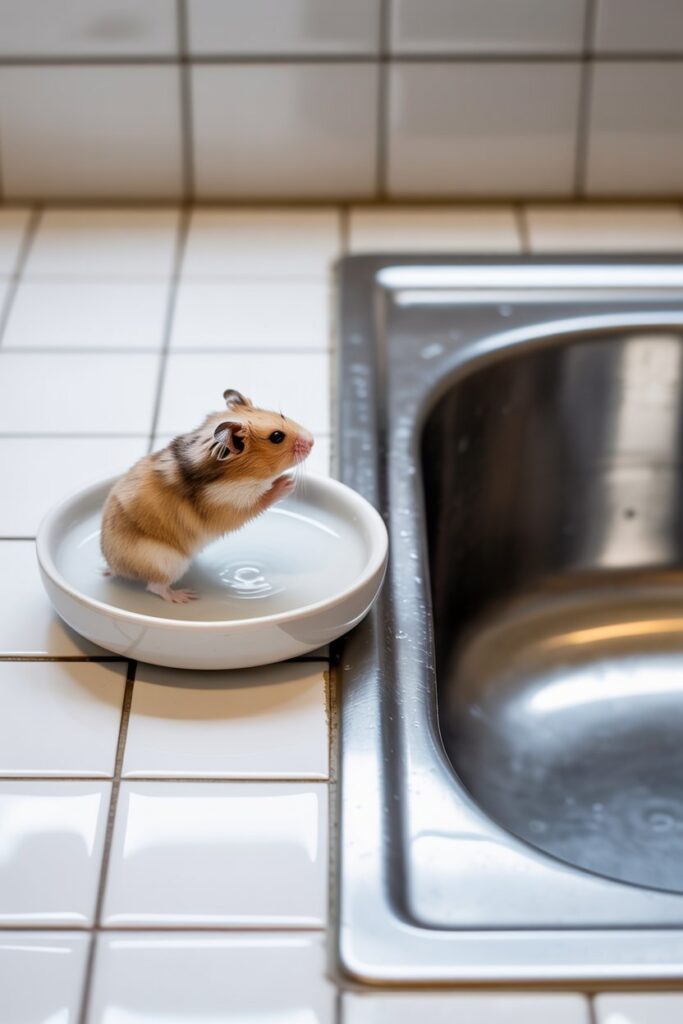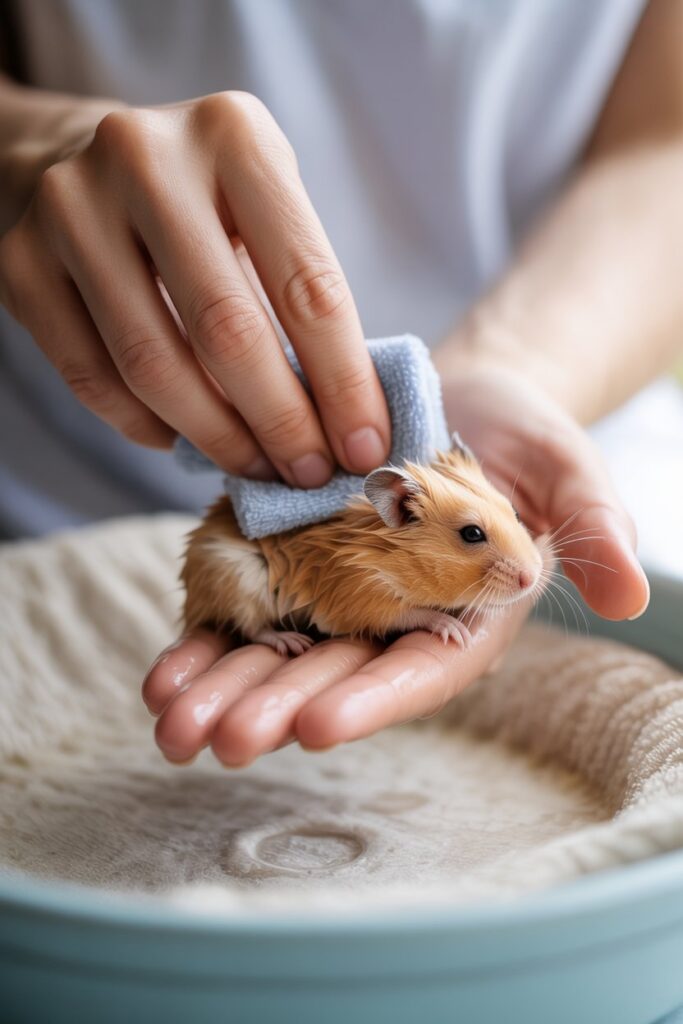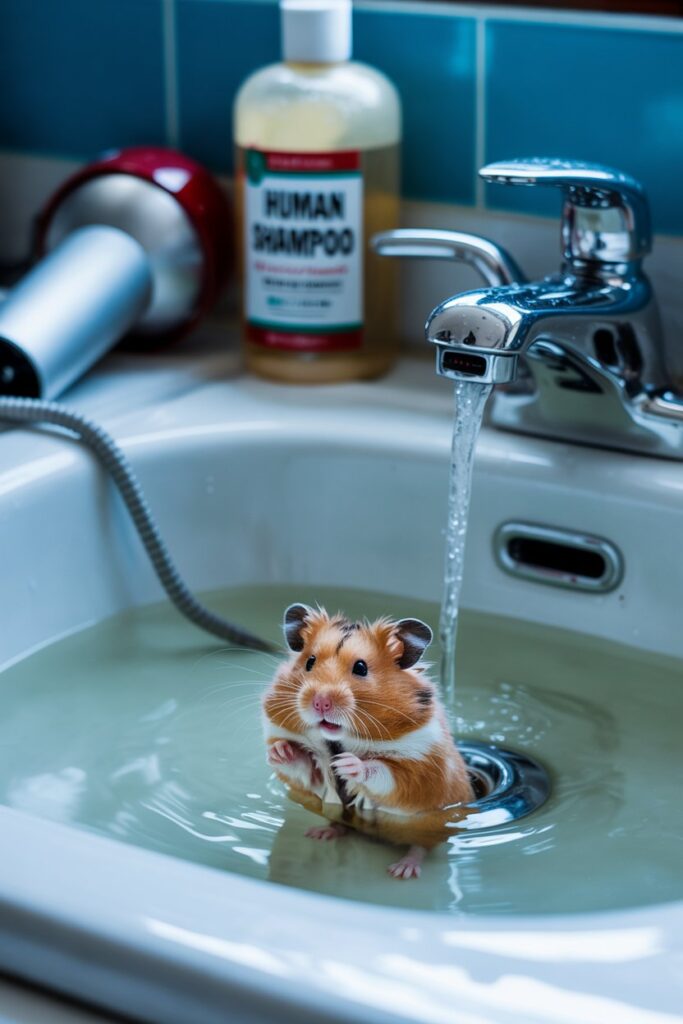Safe hamster bathing is key to keeping your furry friend healthy. This is especially true for beginners learning pet care basics.
Unlike other pets, hamsters should never be bathed in water. Water can stress them out, strip their fur of essential oils, and cause health issues.
Instead, use safe methods like sand baths or gentle spot cleaning. These options keep your hamster fresh without risking their health.
In this guide, we’ll cover everything you need to know about safe hamster bathing. You’ll learn why traditional baths are harmful and discover the best alternatives.
By the end, you’ll feel confident in caring for your hamster while keeping them happy and healthy.
Pre-Bath Checklist

Before bathing your hamster, gather the needed items: a shallow dish, lukewarm water, and a small towel. This will make the process smoother and less stressful for your pet.
Check your hamster’s health first. Look for signs like lethargy, sneezing, or strange behavior. Only bathe a healthy hamster. A sick one may become more stressed or worsen from the bath.
Make sure the bathing area is calm and quiet. Avoid loud noises and sudden movements. A peaceful space will help your hamster relax and enjoy the bath.
Check these hamster bathing essentials available now on Amazon
Choosing the Right Bath

Hamsters love sand baths. These baths help keep their fur clean by removing excess oils. Setting one up is easy and can be a fun activity for your pet. Always use specially designed hamster sand for safety and effectiveness.
Avoid water baths for hamsters. They can cause stress and lead to health issues like colds or skin problems. If your hamster gets dirty, use a damp cloth to clean the area instead of giving a full water bath.
Regular sand baths prevent dirt and oil buildup, keeping your hamster healthy. Replace the sand often to maintain cleanliness. Sand baths also let hamsters groom themselves naturally, which is vital for their well-being.
Shop safe hamster care products directly on Amazon today
Gentle Bathing Steps

To bathe a hamster safely, start with a shallow dish of lukewarm water. Keep the water level low so your hamster feels secure. This makes bathing comfortable and stress-free.
Next, gently place your hamster in the water, supporting its body. Don’t use soap or shampoo; they can harm your hamster’s sensitive skin. Instead, use a damp cloth to clean any dirty spots.
After the bath, wrap your hamster in a soft towel to dry it off. Keep your pet warm and away from drafts. This helps your hamster stay cozy and reduces the risk of getting cold.
Post-Bath Care

After giving your hamster a bath, dry them off completely. Use a soft, clean towel to pat them gently. Make sure to get into all the nooks and crannies to prevent moisture that can cause skin problems.
Keep your hamster warm after their bath. Place them in a cozy, dry area. You can use a small, heated pad under their bedding, but ensure it’s not too hot. Keeping them warm helps prevent colds.
Watch your hamster closely after their bath. Check for signs of stress or illness, like shivering or lethargy. If you notice anything unusual, consult a veterinarian for advice.
Discover beginner-friendly hamster bathing supplies on Amazon here
Common Bathing Mistakes

One common mistake is using water to bathe your hamster. Water baths can stress them out. Their skin may also become dry and irritated. Instead, use a sand bath made for small pets. It keeps them clean and comfortable.
Another error is not providing enough sand for the bath. Hamsters need enough sand to roll around and clean themselves. Ensure the sand is deep enough. Use sand meant for hamsters, as some types can be harmful.
Avoid scented or dusty sand. It can hurt your hamster’s lungs. Choose unscented, dust-free sand to keep your pet healthy. Change the sand regularly to keep it clean and free from bacteria or mold.
Conclusion
Bathing your hamster safely means knowing their needs, using proper materials, and being gentle.
Follow these steps to keep your hamster clean and healthy without stress. Always make the experience calm and comfortable for your pet.
Why Should Hamsters Avoid Water Baths?
Hamsters should avoid water baths. Water can strip essential oils from their fur, cause stress, and lead to health issues like colds or skin irritation. These little pets can’t handle wet fur and may get chilled quickly.
In nature, hamsters groom themselves without water. Their coats are made to stay dry. Bathing them in water disrupts this natural process and can make them uncomfortable or sick.
What Is a Sand Bath for Hamsters?
A sand bath is a container filled with pet-safe sand. It lets your hamster roll around and clean its fur naturally. The sand absorbs excess oils and removes dirt without hurting the hamster’s skin.
Unlike water, sand offers a safe and fun way for hamsters to groom themselves. Always use dust-free, unscented sand made for small pets. This helps prevent respiratory issues.
How Often Should I Give My Hamster a Sand Bath?
Most hamsters like a sand bath a few times a week. Some owners keep a small sand bath in the enclosure full-time. This lets hamsters use it whenever they want.
Using a sand bath regularly helps keep their coat clean and supports natural grooming. Remember to replace the sand often to keep it fresh and clean.
Can I Use Baby Wipes to Clean My Hamster?
You can use unscented, pet-safe wipes for spot cleaning. However, use them only occasionally and on small dirty areas. Avoid wipes with fragrances, alcohol, or harsh chemicals.
Spot cleaning with a damp cloth is often better. It removes dirt without exposing your hamster to extra chemicals or moisture.
What Should I Do If My Hamster Gets Really Dirty?
If your hamster gets messy or sticky, begin with a sand bath or use a damp cloth for spot cleaning. Don’t fully submerge your hamster in water.
If the dirt won’t come off and your pet seems uncomfortable, ask a veterinarian for safe cleaning advice. This keeps your hamster healthy and reduces stress.
